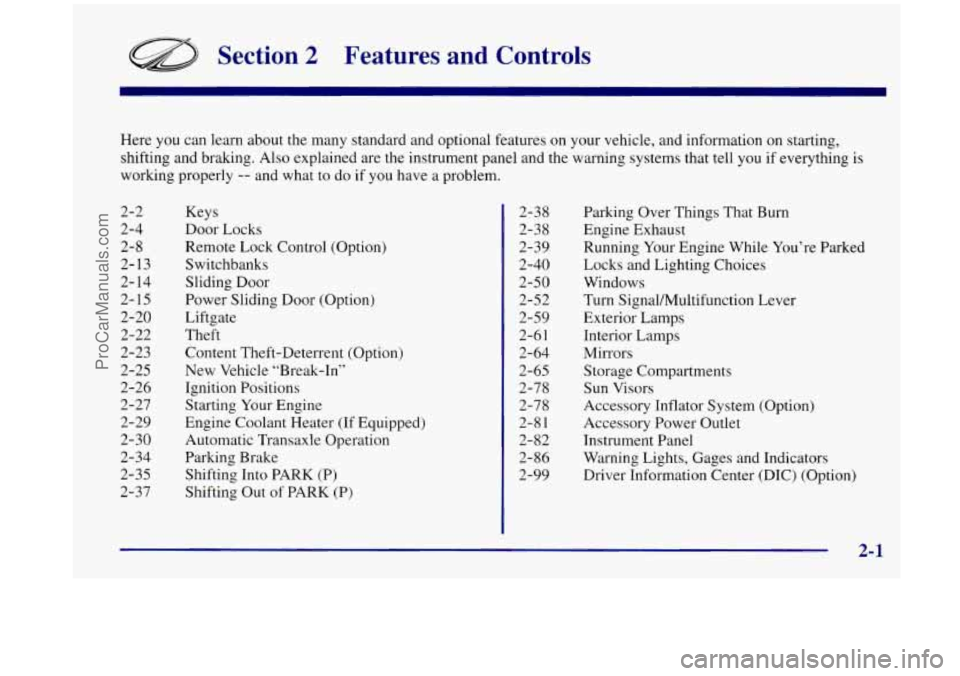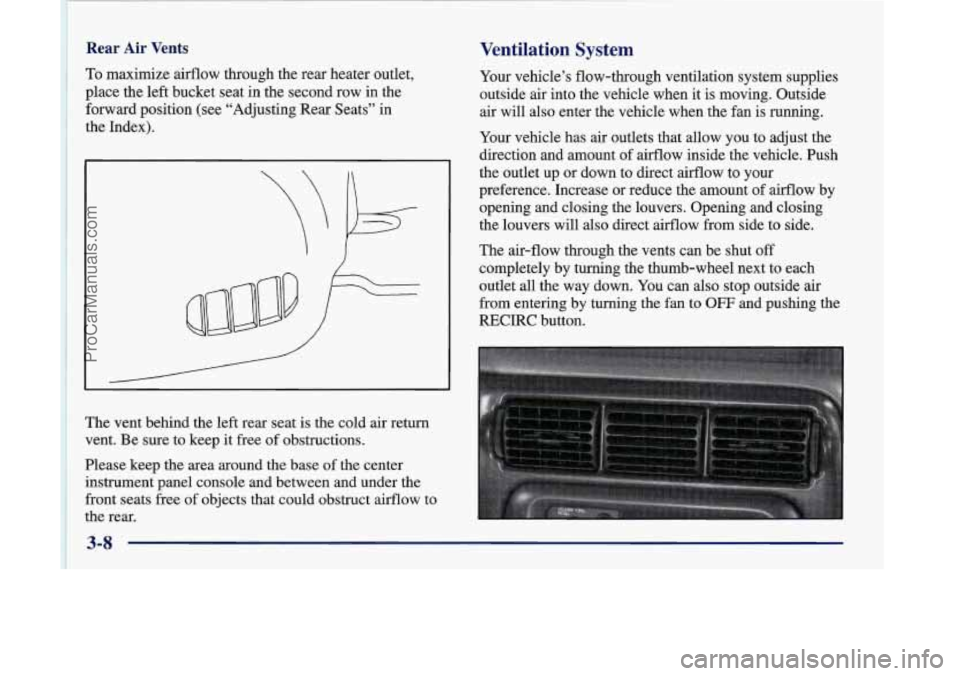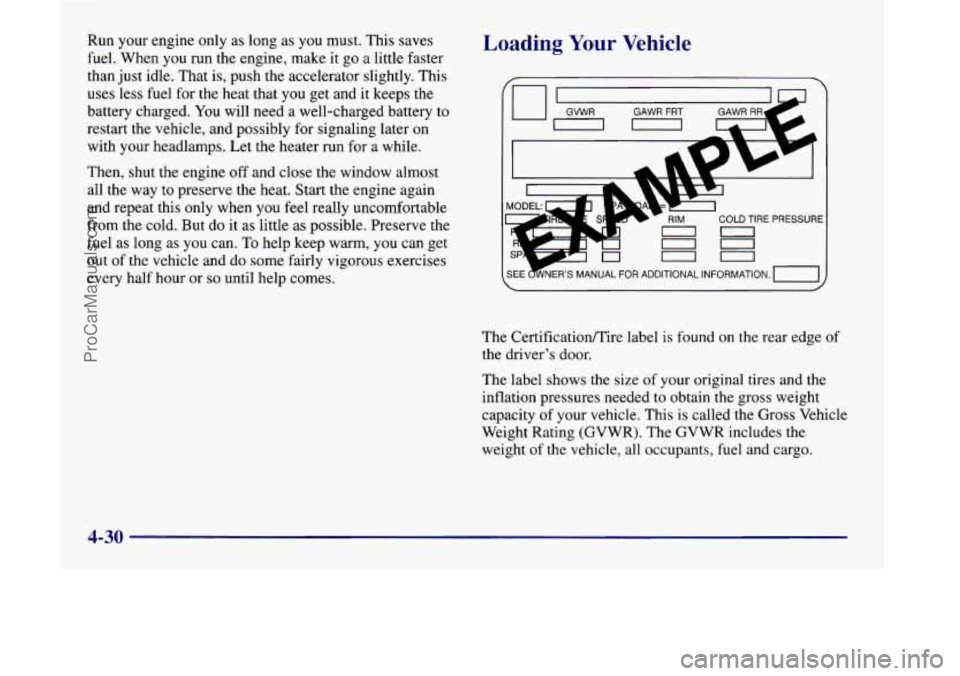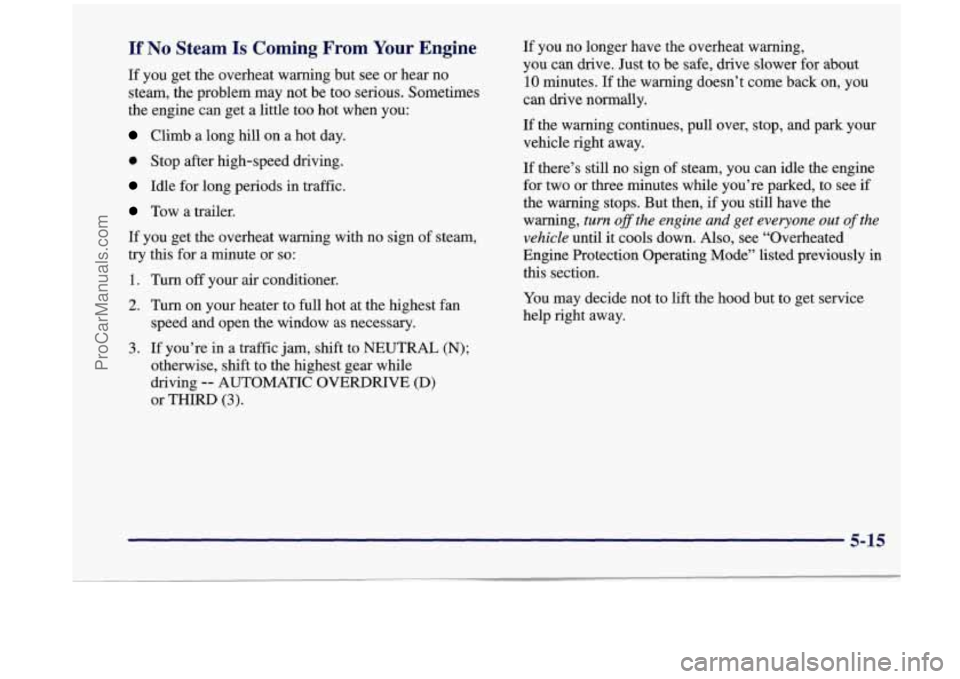1998 OLDSMOBILE SILHOUETTE heater
[x] Cancel search: heaterPage 103 of 444

Section 2 Features and Controls
Here you can learn about the many standard and optional features on your vehicle, and information on starting,
shifting and braking. Also explained are the instrument panel and the warning systems that tell you if everything is
working properly
-- and what to do if you have a problem.
2-2
2-4
2-8
2-13
2-
14
2-15
2-20
2-22
2-23
2-25
2-26
2-27
2-29
2-30
2-34 2-35
2-37 Keys
Door Locks
Remote Lock Control (Option)
Switchbanks
Sliding Door
Power Sliding Door (Option)
Liftgate
Theft
Content Theft-Deterrent (Option)
New Vehicle “Break-In”
Ignition Positions
Starting Your Engine
Engine Coolant Heater
(If Equipped)
Automatic Transaxle Operation
Parking Brake
Shifting Into PARK
(P)
Shifting Out of PARK (P)
2-38
2-38
2-39
2-40
2-50
2-52
2-59
2-6
1
2-64
2-65
2-78
2-78
2-8
1
2-82
2-86 2-99 Parking Over Things
That Burn
Engine Exhaust
Running Your Engine While You’re Parked
Locks and Lighting Choices
Windows
Turn SignalMultifunction Lever
Exterior Lamps
Interior Lamps
Mirrors Storage Compartments
Sun Visors
Accessory Inflator System (Option)
Accessory Power Outlet
Instrument Panel
Warning Lights, Gages and Indicators
Driver Information Center (DIC) (Option)
2-1
ProCarManuals.com
Page 131 of 444

Engine Coolant Heater (If Equipped) 3. Plug it into a normal, grounded 110-volt AC outlet.
Plugging the cord into
an ungrounded outlet
could cause an electrical shock. Also, the wrong
kind
of extension cord could overheat and cause
a fire. You could be seriously injured. Plug the
cord into
a properly grounded three-prong
110-volt
AC outlet. If the cord won’t reach, use a
heavy-duty three-prong extension cord rated for
at least
15 amps.
In very cold weather,
0°F (- 18 “C) or colder, the engine
coolant heater can help. You’ll get easier starting and
better fuel economy during engine warm-up. Usually,
the coolant heater should be plugged in a minimum of
four hours prior to starting your vehicle.
To Use the Engine Coolant Heater
1. Turn off the engine.
2. Open the hood and unwrap the electrical cord.
4. Before starting the engine, be sure to unplug and
store the cord as it was before to keep it away from
moving engine parts.
If you don’t, it could
be damaged.
How long should
you keep the coolant heater plugged
in? The answer depends on the outside temperature, the
kind
of oil you have, and some other things. Instead of
trying to list everything here, we ask that you contact
your retailer in the area where you’ll be parking your
vehicle. The retailer can give
you the best advice for that
particular area.
2-29
ProCarManuals.com
Page 206 of 444

Comfort Controls
This section tells you how to make your air system work
for you. Your comfort control system uses
ozone-friendly
R- 134a refrigerant.
With these systems,
you can control the heating, cooling
and ventilation
in your vehicle. Your vehicle also has a
flow-through ventilation system described later
in
this section.
Fan Knob
The left knob is the fan knob and selects the force of air
you want. Turn the knob to the right to increase fan
speed and to the left to decrease fan speed. The fan must be turned on
for the air conditioning compressor
to operate.
Temperature Knob
The center knob controls the temperature of the air
coming through the system. Turn it to the left (toward
the blue area) for cooler air. Turn it to the right (toward
the red area) for warmer air.
Mode Knob
This knob selects the direction of where the air will
enter the vehicle.
/J UPPER: This setting directs outside air through
the instrument panel outlets.
+fl BI-LEV: This setting directs outside air into your
vehicle in two ways. Cooler air is directed toward your
upper body through the front instrument panel outlets,
while warmed air is directed through the heater ducts at
your feet.
+d LOWER: This setting brings in most of the air
through the floor ducts. This setting is also used to send
air to the rear of the vehicle. Keep the area under the
front seats free
of objects that could obstruct airflow to
the rear
of the vehicle.
+0
+e
0
3-2
ProCarManuals.com
Page 208 of 444

Heating
Turn the temperature knob to the right (toward the red
area) to warm the air.
In the LOWER mode, outside air will be brought in and
sent through the floor outlets.
The heater works best if
you keep your windows closed while using it.
Defogging and Defrosting
To rapidly defrost the windshield, turn the temperature
control knob all the way to the right (to the red area) and
turn the mode
knob to DEFROST.
The BI-LEV setting
is designed for use on sunny days
when the air is only moderately warm or cool. On days
like these, the sun may adequately warm your upper
body, but your lower body may not be
warm enough.
For the best results, turn the temperature control knob
to
the middle position, and then adjust it for comfort.
If
you have the optional engine coolant heater and use it
during cold weather, 0 “F (- 18 O C) or lower, your heating
system will provide heat more quickly because the
engine coolant is already warmed. See “Engine Coolant
Heater” in
the Index. Adjust the
fan to the highest speed.
To keep the windshield clear and bring in heated air
through the heater ducts, turn the mode knob
to DEFOG.
When the temperature outside
is above freezing, the air
conditioner compressor will run in these settings to help
remove moisture from the air.
Your vehicle is equipped with side window defogger
vents located
on the top of the instrument panel. For
additional side window defogging, turn the mode knob
to the BI-LEVEL setting and adjust the fan to the
highest speed. Aim the
side vents on the instrument
panel toward the side windows. For increased airflow to
the side vents, close the center vents.
3-4
ProCarManuals.com
Page 212 of 444

~ 1 To maximize airflow through the rear heater outlet,
i place the
left bucket seat in the second row in the
~ forward position (see “Adjusting Rear Seats” in
1 the Index).
Rear Air Vents
I
~
1 ~ vent. Be sure to keep it free of obstructions.
~ Please keep the area around the base of the center ’ instrument panel console and between and under the
~ front seats free of objects that could obstruct airflow to
~ the rear.
The
vent behind
the left rear seat is the cold air return
~
Ventilation System
Your vehicle’s flow-through ventilation system supplies
outside air into the vehicle when it is moving. Outside
air will also enter the vehicle when the fan
is running.
Your vehicle has
air outlets that allow you to adjust the
direction and amount
of airflow inside the vehicle. Push
the outlet up or down to direct airflow to your
preference. Increase or reduce the amount of airflow by
opening and closing the louvers. Opening and closing
the louvers will
also direct airflow from side to side.
The air-flow through the vents can be shut
off
completely by turning the thumb-wheel next to each
outlet all the way down. You can also stop outside air
from entering by turning the fan
to OFF and pushing the
RECIRC button.
ProCarManuals.com
Page 213 of 444

Ventilation Tips
Keep the hood and front air inlet free of ice, snow or
any other obstruction (such as leaves). This will
allow the heater and defroster to work much better,
reducing the chance of fogging the inside of
your windows.
When you enter a vehicle in cold weather, turn the
blower fan to
5 for a few moments before driving
off. This helps clear the intake ducts of snow and
moisture, and reduces the chance of fogging the
inside of your windows.
instrument panel console and the air path under the
front seats clear of objects. This helps air to circulate
throughout your vehicle.
Keep the area around the base of the center
In cold weather, operating the system in the
OUTSIDE AIR mode will improve the time it takes
to warm the vehicle.
Audio Systems
Your Delco Electronics audio system has been designed
to operate easily and give years
of listening pleasure.
You will get the most enjoyment out of it if you acquaint
yourself with it first. Find out what your Delco
Electronics system can do and how to operate all its
controls, to be sure you’re getting the most out of the
advanced engineering that went into it.
Setting the Clock for All Systems
Press and hold HR until the correct hour appears. Press
and hold
MN until the correct minute appears.
ProCarManuals.com
Page 262 of 444

Run your engine only as long as you must. This saves
fuel. When you run the engine, make it go a little faster
than just idle. That is, push the accelerator slightly. This
uses less fuel for the heat that you get and it keeps the
battery charged. You will need a well-charged battery to
restart the vehicle, and possibly for signaling later on
with your headlamps. Let the heater run for a while.
Then, shut the engine
off and close the window almost
all the way to preserve the heat. Start the engine again
and repeat this only when you feel really uncomfortable
from the cold. But do it as little as possible. Preserve the
fuel as long as you can. To help keep warm, you can get
out of the vehicle and do some fairly vigorous exercises
every half hour or so until help comes.
Loading Your Vehicle
GAWR FRT
COLD TIRE PRESSURE
00 n-
SEE %ER’S MANUAL FOR ADDITIONAL INFORMATION. -1
The Certificatioflire label is found on the rear edge of
the driver’s door.
The label shows the size of your original tires and the
inflation pressures needed to obtain the gross weight
capacity of your vehicle. This is called the Gross Vehicle
Weight Rating (GVWR). The GVWR includes the
weight of the vehicle, all occupants, fuel and cargo.
4-30
ProCarManuals.com
Page 289 of 444

If No Steam Is Coming From Your Engine
If you get the overheat warning but see or hear no
steam, the problem may not be too serious. Sometimes
the engine can get a little too hot when you:
Climb a long hill on a hot day.
0 Stop after high-speed driving.
Idle for long periods in traffic.
Tow a trailer.
If you get the overheat warning with no sign of steam,
try this for a minute or
so:
1. Turn off your air conditioner.
2. Turn on your heater to full hot at the highest fan
speed and open the window as necessary.
3. If you’re in a traffic jam, shift to NEUTRAL (N);
otherwise, shift to the highest gear while
driving
-- AUTOMATIC OVERDRIVE (D)
or THIRD (3).
If you no longer have the overheat warning,
you can drive. Just to be safe, drive slower for about
10 minutes. If the warning doesn’t come back on, you
can drive normally.
If the warning continues, pull over, stop, and park your
vehicle right away.
If there’s still no sign of steam, you can idle the engine
for two or three minutes while you’re parked, to see
if
the warning stops. But then, if you still have the
warning,
turn off the engine and get everyone out of the
vehicle
until it cools down. Also, see “Overheated
Engine Protection Operating Mode” listed previously in
this section.
You may decide not to lift the hood but to get service
help right away.
5-15
ProCarManuals.com